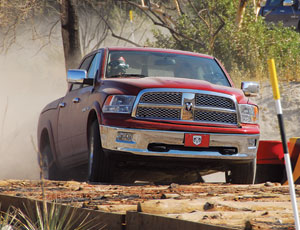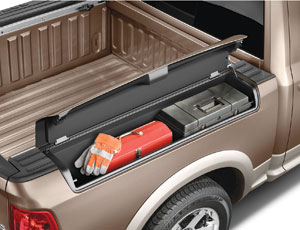Retail and office construction are in decline. Banks are playing Scrooge with new bailout bucks. For-sale signs line the street, and housing starts keep receding.These are tough times, when every dollar spent on capital equipment must be spent wisely. For working people in need of a new truck, that need translates into a pickup that not only leads in raw grunt but also fuel economy and utility. ENR evaluated two redesigned models, the 2009 Ford F-150 and 2009 Dodge Ram 1500, to determine which workhorse truly deserves a spot at the jobsite.
Starting at $22,170, the 2009 Dodge Ram’s trims range from the base ST to the luxed-out Laramie, and buyers can opt for the Regular, Quad or new Crew Cab style. Prices for the 2009 Ford F-150 start at $21,320. The lineup includes seven trims and Regular Cab, SuperCab, and SuperCrew models.
In terms of power, both truck makers have upped the game. Ford has scrapped the V6 from the F-150 lineup and has updated its 5.4L V8, now good for 310 hp and 365 lb-ft of torque (390 lb-ft when operating on ethanol), as the truck’s most robust powerplant.
The refined engine left us unimpressed with its performance, offering adequate response around town and feeling a bit weak when pushed for highway passes. However, gearing allows a new six-speed transmission to exploit every hoof of what the 5.4L ponies up, providing decent off-the-line acceleration and fuel efficiency of up to 20 mpg. And a new “SFE” package swaps in a 24-valve, 4.6L V8 engine and a 3.15 axle ratio to squeeze out just one more mile per gallon, putting it on par with the class-leading Chevrolet Silverado XFE’s 21 mpg.
Dodge uses cylinder-deactivation technology to help its 5.7L HEMI V8 achieve up to 20 mpg, same as the Ram’s base V6. Though its highway fuel economy rating matches the Ford’s 20 mpg (despite using a five-speed tranny), Dodge’s HEMI produces a whopping 390 hp and 407 lb-ft of torque. Giddy up.
Pulling Power
What’s under the hood in one thing, but how do these beasts of burden work under load? If you were under the impression that a Dodge boasting 407 lb-ft of rock-crushing twist would handily outperform a Ford with only 365 lb-ft of torque, prepare to be surprised. Even with its brutish HEMI, the 2009 Ram offers a towing capacity of only 9,100 lb and payload capability that peaks at 1,850 lb. The 2009 Ford F-150 ups those figures to 11,300 and 3,030 lb, respectively.
Part of the distinction comes from the trucks’ varied rear suspensions. As we reported earlier this year, the Ram steers away from tradition by using coil springs, whereas the F-150 receives longer and wider leaf springs for 2009. Dodge engineered the Ram for improved ride and handling, something that Ford achieved nearly as well while providing class-leading capability.
We recently put the trucks to the test with loaded trailers and beds. For quick take offs, the Dodge just couldn’t be beat, though even in tow/haul mode the transmission had difficulty choosing the correct gear. The F-150 was slower but smoother, required just a light tap of the brakes to initiate a helpful downshift, and was noticeably more stable thanks to standard Trailer Sway Control. Furthermore, the F-150 can be had with the Integrated Trailer Brake Controller, first offered on the larger Super Duty.
Precious Cargo
It may be surprisingly powerful, not to mention comfortable, but it is the innovative RamBox that stands to be Dodge’s saving grace. Available on the new Crew Cab, this $1,895 feature adds 7.4 cubic feet of lockable, waterproof, drainable, and illuminated storage. The RamBox provides a secure spot for a variety of tools, leaves enough bed width to accommodate a standard sheet of plywood, and is accompanied by a bed divider and collapsible bed extender. Of course, there are downsides to this nifty contraption, such as the inability to secure a rack system or shell. A strange safety feature of the RamBox, which is technically a trunk, is a regulation-required cord that opens the latch in case a very small person gets locked inside. Other Ram features include storage wells in the cabin’s rear floor, and luxuries such as Sirius satellite TV and a heated rear seat.
Ford traveled an alternate path when developing features for the 2009 F-150. The Super Duty’s tailgate step is now available on the half-ton model; a new cargo management system supports up to 600 lb and removable, waterproof plastic bins, capable of holding up to 60 lb, are available. To address complaints about the F-150’s tall bed, a set of retractable side steps are being offered for $325. Granted, truckers like the box’s capacity, but easy access should be free— not more than three bills.
Crew cab versions of these trucks provide ample interior space, but it’s the F-150 that delivers a truly flat, rear-load floor. Also exclusive to Ford is its new “Work Solutions” technology. Most anyone will enjoy the available high-speed Internet access, but contractors and foremen will surely appreciate the ability to manage files and print invoices from the convenience of their trucks. There also is a computer-based tool-tracking system developed in partnership with DEWALT and a Master Lock cable system that secures all items in the bed. A fleet-management program allows business owners to track the location of and perform diagnostics on their work vehicles.
Truck buyers come in all flavors, but chances are construction professionals will want their rigs to be comfortable and efficient. More importantly, their machines will have to work and play hard. Though it is attractive, fast, and innovative, the 2009 Dodge Ram comes up short in professional-grade capability and fails to match the breadth of technology offered in Ford’s Work Solutions system. For these reasons and more, we give our nod of approval to the 2009 Ford F-150.











Post a comment to this article
Report Abusive Comment